





Introduced: 2002 (standard version), 2004 (semi-streamlined version), 2005 (Vandy tender version), 2010 (revised semi-streamlined version), and 2015 (revised MRC version)
This was the first in a line of Korean-made steam locomotives from Model Power. Said line would eventually include (along with this Pacific) a 2-8-2 Mikado, a 4-4-0 American and a 2-6-0 Mogul. All of them have nice looking, finely detailed metal shells. Similarly, they all share the same basic internal design characteristics. And unfortunately, the entire line is (for the most part) a hugely mixed bag in terms of their quality.
In 2014, Model Power went out of business and was subsequently acquired by MRC. In 2015, MRC released revised versions of these models (still in the old Model Power packaging, but with MRC mentioned on the back of the box). These new models are a considerable upgrade over the original Model Power releases (and available with DCC-Sound), but before we discuss those let's first take a look at the older ones -

The shell and mechanism are a total Chinese puzzle box of interconnected parts and, as a consequence, extremely difficult to disassemble. To separate the shell from the chassis, you first have to unscrew the pilot and trailing truck screws. The boiler section should separate from the chassis at this point. However, given all the wiring running back to the tender, you won't be able to move it very far.
The motor, flywheel, driveshaft and worm all live up inside the boiler. To access the motor (and beyond) you have to first completely remove the cab (held to the bottom of the boiler by a couple of plastic clips). Next, remove the boiler backplate "detail" as well as the round plastic "thing-a-ma-dealie" clipped to the motor. The motor, flywheel and worm should all slide out of the back of the boiler at that point (in theory, anyway - I've never actually tried).
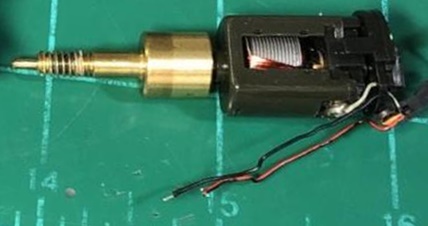
The chassis is a mixture of plastic and metal parts. The motor is an open-sided / skew-wound 3-poler. As alluded to above, the driveshaft includes a flywheel (and a rather large one at that). All three sets of drivers are geared, and with the exception of the brass worm, all gearing is plastic. A non-directional headlight is mounted to the chassis (and rather inexplicably, only receives current from the forward set of drivers - making for a very flickery headlight). All six drivers provide pickup (or at least the ones without traction tires do). The pilot and trailing trucks provide no pickup whatsoever. As noted above, current is ferried around via a veritable rat's nest of wiring.
The pilot truck has a spring providing downward pressure. The pilot coupler is a dummy (non-operational) knuckle, although it does pivot. The tender coupler is truck-mounted and either a Rapido (pre-2010) or a McHenry (post-2010). The Rapido couplers are easily replaced by a Micro-Trains coupler assembly. The plastic drawbar holds all of the wiring running between the locomotive and the tender. It hooks onto posts on the tender and locomotive chasses (sandwiched between the shells and the chasses). All wheels are blackened and low-profile (no problems on Code-55 rails). The trailing truck varies by prototype (either Delta or USRA). Undecorated units come with both.
These models were originally released without any sort of traction tire assist on their drivers. However, once their anemic pulling power became evident, Model Power starting offering after-the-fact TT-equipped driversets (to be installed by the modeler). Unfortunately, installation of said ala carte drivers turned out to be a nightmarishly diabolical operation (and definitely not for the faint of heart). As a consequence, Model Power eventually (after about the third production run) started installing the traction tires at the factory.
Tender pickup has similarly evolved. The first run of 4-6-2's came with a tragically awful tender pickup scheme - a small spring (one per truck) squashed between an axle and a hole in the tender chassis. This transferred current from one truck wheel, to the axle, to the spring, into the tender, and eventually (via the drawbar wiring) to the motor. And as sad as wasting six out of the eight tender wheels was, the fact that said springs tended to dislodge and go flying off into the ether on curves definitely added insult to injury.
To their credit, Model Power quickly addressed the whole spring situation on the second run. Unfortunately, their "brilliant solution" was to replace the springs with flimsy 1970's-style axle wipers. And yes, this did double the number of wheels providing pickup (two wheels on the rear truck picking up left-rail current, and two wheels on the forward truck picking up right-rail current). But come on... axle wipers?

In addition to its other problems, the first run of Pacifics was also a fairly noisy bunch. This was (presumably) addressed in subsequent runs by adding a plastic ring that keeps the flyworm from hitting the shell (or at least I'm assuming that's what it's there for, but do feel free to send me your guesses).
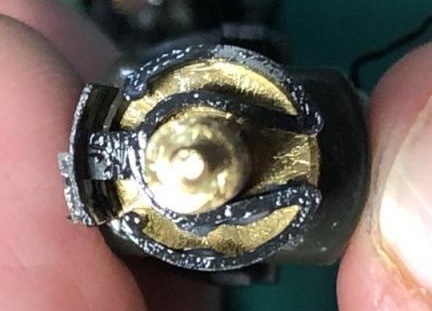
A removeable plate was added to the chassis to accommodate the insertion of this part. A screw holds the plate in place, so if you don't see that screw you have a very old (and probably noisy) version.
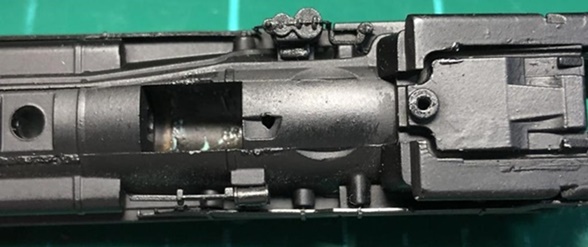
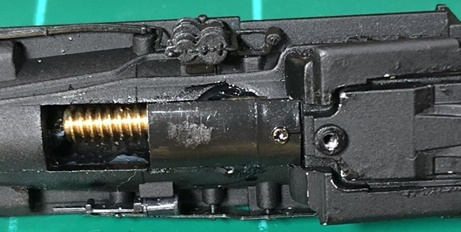
The kinda/sorta good news is that this model is kinda/sorta DCC-Ready. Ajin has provided color-coded wiring leads in the tender for pickup and motor control (unfortunately, there is no wiring for headlight control). So, no, not a simple plug'n'play decoder install. But still, about as painless as it gets otherwise -
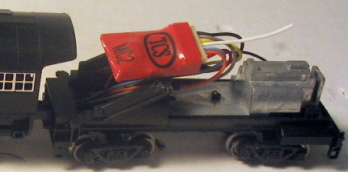
These original Model Power models are difficult to review, as my experiences with them have varied wildly. In general, they look sharp and (when they run) run very well. The good ones are reasonably smooth and reasonably quiet, perform well at slow speeds and don't have any pickup problems. On the other hand, the less good ones are louder and more herky-jerky. And the bad ones? Well, they tend to fall apart before your very eyes (before ultimately seizing up). And none of them pull worth a darn unless they have the traction tires.
The two main problems with this locomotive are both pickup related. First off, those axle wipers on the tender - an extremely inefficient and unreliable scheme that should've been retired back in the 1970s. If you de-box one of these things and find that it's stalling out every few inches, go check out the axle wipers on the tender trucks. No doubt that's where your problems start... A common solution to the tender pickup problem is to simply replace the tender trucks with all-wheel pickup versions from Kato or Bachmann.
The other problem (vis'a'vis pickup) relates to the flimsy metal wipers behind the drivers. Said wipers are prone to losing their contact (or worse still, becoming bent and mangled by the drivers themselves - basically causing the locomotive to seize up entirely). And once mangled, they are not easy to de-mangle. And mangling aside, they're total dirt magnets (and not particularly easy to access and clean).
Beyond the basic design flaws, there are also just all sorts of QC issues with these things. Common maladies are misaligned cranks and rods, out-of-quarter drivers, out-of-gauge wheels, etc (and with the end result being a lot of wobbling, binding, derailing, and out-and-out seizing up). And even if you get one that runs well in a simple "straight test track" environment, beware running it on a layout that has a lot of grades and/or sharp curves. My experience is that the pilot truck (and occasionally even the drivers) have just one hell of a time staying on the rails when faced with curves sharper than 11"-radius (particularly uphill and downhill curves). Removing the factory-installed spring from the pilot truck reportedly goes a long way towards solving these issues.
Model Power released a slightly revised version of their semi-streamlined 4-6-2 in 2010, with the only real change being a new truck-mounted McHenry-style coupler on the tender (and a rather klunky looking one at that). Said coupler is "height adjustable" (which is basically a nice way of saying that it's prone to falling apart if you're not careful with it) -
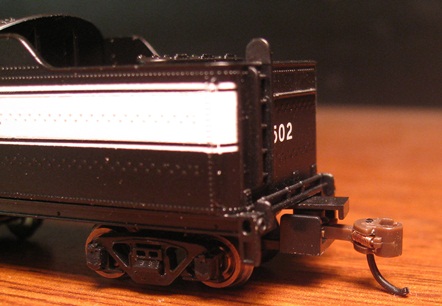
As noted above, revised versions of these models were released under the MRC label in 2015. And I must say, although not the total "do over" that we might have hoped for, the handful of minor tweaks executed by Ajin were certainly sufficient enough to move these models up into the "A" category here.
On the engine side of things, the chassis-mounted filament bulb for the headlight was replaced by an LED lightboard mounted inside of the boiler. Better still, said lightboard receives its current by way of a pair of wires running back to the tender. IE, yes, the DCC guys can now use their decoders for headlight control. As for the analog crowd? Sorry, it's still non-directional (go figure!)
MRC claims that the worm and idler gearing was improved "for smoother operation". However, apart from the color of the plastic (dark gray on the new version, black on the old), all of the gearing looks the same to me. So, I dunno, maybe it's just better plastic?

MRC also advertised the driver wipers as being "improved", but as near as I can tell the only difference is that they are silver in color (as opposed to the earlier wipers, which were copper colored). So, although the composition of the metal changed, the original sub-optimal design is still in play. What did change is that wiper extensions were added to collect current from the rear two wheels on the pilot truck -

On the tender side of things, the trucks received the same axle wiper upgrade that was first introduced on the Micro-Trains / Ajin 4-4-0 - namely, stiff metal wipers with insulated mini-wires running directly into the tender. The tender coupler is the same truck-mounted McHenry-style coupler introduced in 2010 (and yes, still klunky looking and still prone to falling apart) -
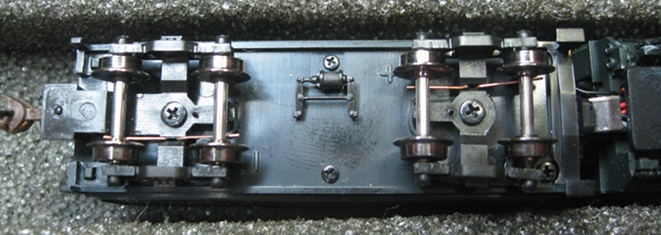
MRC also advertised "notched driver axles" as being a new feature. However, it turns out that this didn't mean what pretty much everyone in the world assumed it would mean. What Ajin did was notch the axles where they insert into the axle gears (as opposed to where they insert into the drivers). Now, I don't know if slipping axle gears was ever a big problem with the original design, but slipping drivers certainly was (at least for some people). Unfortunately, this remains a potential source of trouble on the revised version. As you can see, the axles are simply round spindles that plug into round holes in the drivers (thus allowing the drivers to work themselves out of quarter if the axles ever slip) -

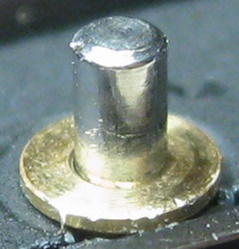
Despite the somewhat misleading advertising, I can't really argue with the results of what did get changed. My 2015 Pacific is just one flat out amazing performer. It runs smoothly and quietly at all throttle levels. No shimmying, shaking, wobbling, binding, stuttering or stalling whatsoever. Excellent slow-speed creep and a nicely reasonable top-end speed. And wow, you want pulling power? I swear, I ran out of heavyweight passenger cars (25!) before coming anywhere near this thing's limit. Overall, just a superb runner. Now, let's just hope that Ajin has put their QC problems behind them and that they're all as good as the one I tested.
One minor caveat - these models do not come with any sort of lubrication (or at least mine didn't). And as far as the gearing goes, maybe that's OK. However, mine started emitting all sorts of annoying squeaking sounds after about an hour of running time, and the problem turned out to be the driver axles. Fortunately, I was able to solve the problem by applying a bit of oil to said axles (where they slide into their brass bushings). Once suitably oiled up, all of the squeaking went away.
As noted above, MRC also sells DCC-Sound equipped versions of these models (where basically all they've done is soldered a sound decoder to the DCC wiring leads in the tender) -
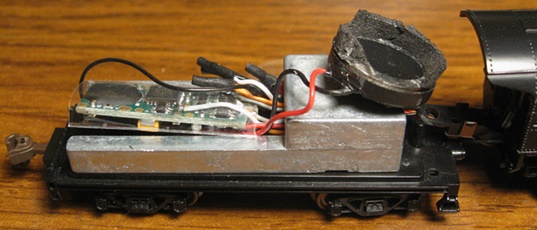
I'm told that the decoder is an MRC 1961 (specifically designed for use on these MRC steamers). The speaker is glued to a foam ring, which is in turn glued to the inside of the tender shell (sloppily removed here for photographic purposes). The tender itself was not modified for sound (IE there aren't any speaker holes in the chassis or anything like that). Finding the sound on mine to be a bit muted, I went ahead and used a pin vise to drill a few tiny holes in the coal bunker. This improved the sound quality quite a bit (at least to my ear).
In 2019, Heartland Hobby purchased the tooling for the old Model Power line of N scale locomotives from MRC. It's anyone's guess what (if anything) they plan on doing with it, but it's entirely possible that we've seen the last of them.
Grades: C for the original Model Power releases ("F" without the traction tires), and A for the revised MRC version
Reviewed: 04/03 Model Railroader ("Model Power has released a USRA 4-6-2 light Pacific passenger steam locomotive. The N scale, ready-to-run engine includes a die-cast metal boiler and frame and features some nice additional factory-applied metal and plastic detail parts... Model Power's new Pacific closely matches prototype drawings... The wheelbase is correct on both the locomotive and the tender, and the overall dimensions are good. The models have the correct Cole trailing truck and 10,000 gallon USRA tender. However, the tender comes with Andrews trucks found on USRA freight engines and not the Commonwealth trucks used on the Pacifics. The locomotive is powered by a skew-wound open-frame motor and includes a large brass flywheel. The electrically isolated motor assembly is carefully concealed inside the die-cast metal boiler and covered by a detailed plastic backhead. Power for the motor comes from four wheels on each rail (all three sets of drivers and one tender wheelset).
"The non-directional headlight is powered with wipers contacting the front driver set. The model is pre-wired for easy installation of a decoder, complete with proper color-coded wires requiring only minimal soldering. Running wires from the decoder in the tender to the headlight, buried deep in the boiler, however, could be a challenge. The drawbar for the tender neatly conceals the four wires already running to the engine but is too full to include any others. The locomotive runs well but is a bit noisy. It has sufficient power to pull eight passenger cars... After a brief warmup period, the mechanism functioned smoothly, and I could get our sample locomotive to run at about 9 scale mph. Also, the wheelsets have low-profile flanges and roll cleanly on Atlas code 55 track. The engine has a dummy coupler in the pilot and a truck-mounted Rapido-style coupler on the tender... Our samples were neatly decorated... Both locomotives have sharp lettering; however, the gun-metal paint used on the smokebox and firebox was too grainy... Model Power's new USRA Pacific is a nicely proportioned locomotive that's a good value for anyone looking to operate N scale steam passenger service from the 1920's to the '50s. ATSF, B&O, CN, CP, L&N, PRR, Soo, SP, Southern. $139.98")